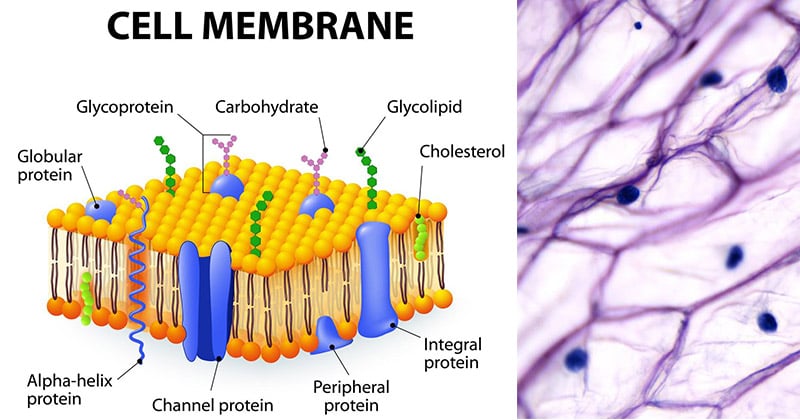- Membranes are lipid structures that separate the contents of the compartment they surround from its environment.
- Plasma membranes separate the cell from its environment while other membranes define the boundaries of organelles and provide a matrix upon which complex chemical reactions can occur.
- The plasma membrane, also known as the cell surface membrane or plasmalemma, defines the boundary of the cell.
- It is a phospholipid bilayer with embedded proteins that encloses every living cell.
- It regulates the movement of materials into and out of the cell and facilitates electrical signaling between them.
- It is said to be semi-permeable because it allows certain molecules but not others to enter into the cell.
- It serves some specific functions such as controlling the flow of nutrients and ions into and out of the cells, mediating the response of a cell to external stimuli (a process called signal transduction), and interacting with bordering cells.

Interesting Science Videos
Structure and Composition of Plasma Membrane
All biological membranes are constructed according to a standard pattern. They consist of a continuous bilayer of amphipathic lipids approximately 5 nm thick, into which proteins are embedded. In addition, some membranes also carry carbohydrates (mono- and oligosaccharides) on their exterior, which are bound to lipids and proteins. The proportions of lipids, proteins, and carbohydrates differ markedly depending on the type of cell and membrane.
- The plasma membrane consists of a lipid bilayer containing embedded and peripheral proteins. The major component of membranes is lipids.
- The lipids in the plasma membrane are in the form of phospholipids, which contain a polar head group attached to two hydrophobic fatty acid tails; the head group faces the aqueous environment, the fatty acid tails the interior of the bilayer.
- Glycerol-based lipids contain a glycerol backbone, and consist of phosphatidic acid (PA), phosphatidylethanolamine (PE), phosphatidylcholine (PC), phosphatidylserine (PS), phosphatidylglycerol (PG), phosphatidylinositol (PI), and cardiolipin (CL).
- The one sphingosine-based lipid is sphingomyelin (SM).
- Cholesterol is present in eukaryotic membranes and maintains membrane fluidity at a variety of temperatures. Fluidity is also determined by the content of unsaturated fatty acids in the membrane, which are liquids at room temperature, and the chain length of the fatty acids (shorter chains are more fluid than longer chains).
- The embedded proteins in the plasma membrane function as either channels or transporters for the movement of compounds across the membrane, as receptors for the binding of hormones and neurotransmitters, or as structural proteins.
- The peripheral membrane proteins provide mechanical support to the membrane through the inner membrane skeleton or the cortical skeleton. An example of this is spectrin in the red blood cell membrane. These can be removed from the membrane by ionic agents.
- The third type of membrane proteins is the glycophosphatidylinositol (GPI) glycan-anchored proteins. One example of a GPI-anchored protein is the prion protein, present in neuronal membranes.
- The plasma membrane glycocalyx consists of short chains of carbohydrates attached to proteins and lipids which extend in the aqueous media and both protects the cell from digestion and restricts the uptake of hydrophobic molecules.
Note:
- Membrane lipids are strongly amphipathic molecules with a polar hydrophilic “head group” and a polar hydrophobic “tail.” In membranes, they are primarily held together by the hydrophobic effect and weak Van der Waals forces and are therefore mobile relative to each other. This gives membranes a more or less fluid quality.
- Lipids and proteins are mobile within the membrane. If they are not fixed in place by special mechanisms, they float within the lipid layer as if in a two-dimensional liquid; biological membranes are therefore also described as being a “fluid mosaic”.
Functions of Membranes (Plasma Membrane and Biological Membranes)
- The most important membranes in animal cells are the plasma membrane, the inner and outer nuclear membranes, the membranes of the endoplasmic reticulum (ER) and the Golgi apparatus, and the inner and outer mitochondrial membranes. Lysosomes, peroxisomes, and various vesicles are also separated from the cytoplasm by membranes.
- In plants, additional membranes are seen in the plastids and vacuoles.
Membranes and their components have the following functions:
- Enclosure and insulation of cells and organelles.
- The enclosure provided by the plasma membrane protects cells from their environment both mechanically and chemically.
- The plasma membrane is essential for maintaining differences in the concentration of many substances between the intracellular and extracellular compartments.
- Regulated transport of substances
- This determines the internal milieu and is a precondition for homeostasis—i. e., the maintenance of constant concentrations of substances and physiological parameters.
- Regulated and selective transport of substances through pores, channels, and transporters is necessary because the cells and organelles are enclosed by membrane systems.
- Signal Transduction
- Reception of extracellular signals and transfer of these signals to the inside of the cell as well as the production of signals.
- Enzymatic catalysis of reactions.
- Important enzymes are located in membranes at the interface between the lipid and aqueous phases. This is where reactions with apolar substrates occur.
- Examples include lipid biosynthesis and the metabolism of apolar xenobiotics. The most important reactions in energy conversion—i. e., oxidative phosphorylation and photosynthesis also occur in membranes.
- Interactions with other cells
- For the purposes of cell fusion and tissue formation, as well as communication with the extracellular matrix.
- Anchoring of the cytoskeleton
- To maintain the shape of cells and organelles and to provide the basis for movement processes.
References
- Smith, C. M., Marks, A. D., Lieberman, M. A., Marks, D. B., & Marks, D. B. (2005). Marks’ basic medical biochemistry: A clinical approach. Philadelphia: Lippincott Williams & Wilkins.
- Koolman, J., & Röhm, K.-H. (2005). Color atlas of biochemistry. Stuttgart: Thieme.
- Alberts, B. (2004). Essential cell biology. New York, NY: Garland Science Pub.
- https://www.mheducation.co.uk/he/chapters/9780071102087.pdf
- http://www.nslc.wustl.edu/courses/bio101/cruz/Organelles/Organelle.htm

Can someone give you this